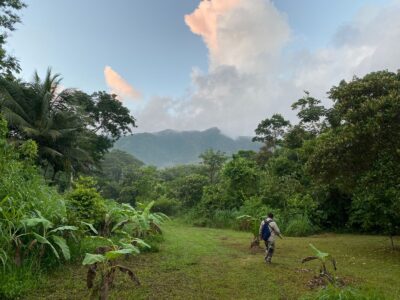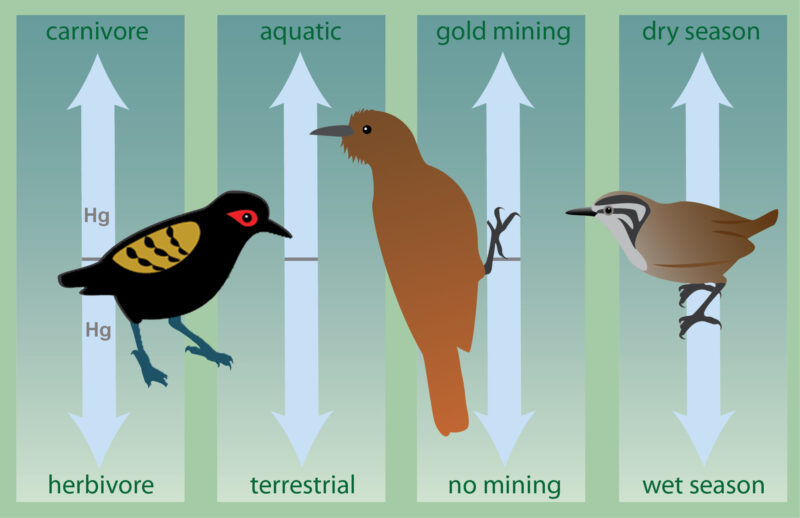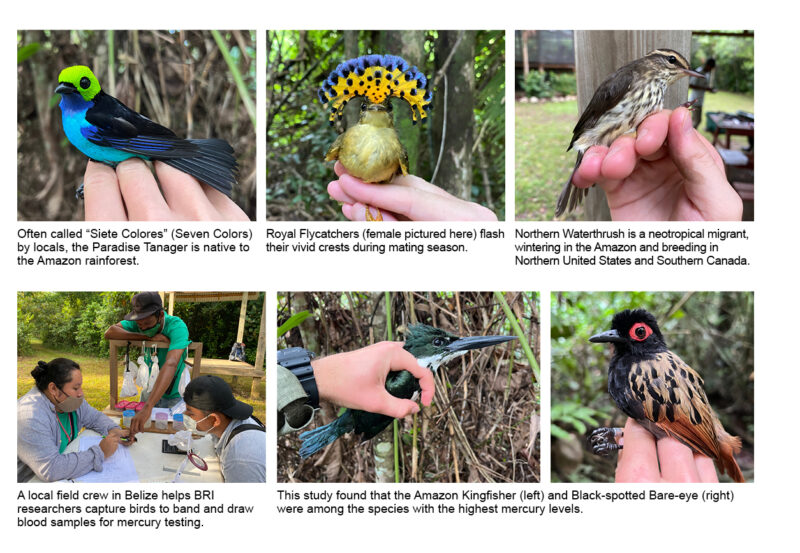Newswise — Neon green hoods, turquoise bellies, ornate crowns—Neotropical birds come in all shapes, sizes, and colors. Combined with unique patterns, textures, and song, they either blend in or stand out in thick jungles filled with hundreds of other species competing for the same or similar resources.
When the first European explorers discovered Central and South America and the West Indies, they called this land the New World Tropics, a region known today as the Neotropics. Here in the dense rain forests of the Amazon, you would not suspect that many of the vibrant and charismatic birds that inhabit these remote areas are regularly exposed to sublethal amounts of mercury. In this seemingly pristine part of the world, how does mercury find its way into these birds?
From affordable common goods to expensive investments, so many of our daily decisions seem inconsequential. But as our awareness grows, we are forced to think before we make a transaction and to ask ourselves a few questions: Where did this product come from? What industry is this tied to? And who, be it person or animal, is paying the price for my purchase?
Many people have some understanding of the ethical dilemma associated with diamond mining. Conflict free, responsibly mined, and ethically sourced are all things we are urged to deliberate when making a selection of this precious gem. But what about gold? It turns out there are similar social and environmental considerations when picking out a pair of hoops. According to the World Gold Council and the World Bank, 15 to 20 million people make artisanal small-scale gold mining (ASGM) their primary source of income. Unlike large-scale gold mining, ASGM takes place outside of formal legal and economic structures, and although the operation itself is small in scale, its prevalence around the world looms large. In addition to labor rights and safety concerns for miners, another metal involved in the gold extraction process poses a threat to entire ecosystems.
Mercury, a dense and silvery fluid, is the only metal in a liquid state at standard room temperature and pressure. Although mercury naturally occurs in small quantities in its elemental form and is usually contained deep in the Earth’s crust, the United Nations Environment Programme found that industrial activities such as ASGM, fossil fuel combustion, and waste incineration increase the amount of mercury released into the environment. Furthermore, mercury rapidly becomes a global issue because of its ability to mobilize far from the source of emission, contaminating soils, waterways, and the atmosphere. Particularly deleterious is the biomagnification (the ability for toxin levels to increase to successively higher concentrations in a food web) property of mercury when transformed to its organic form methylmercury. If exposed under the right conditions, mammals, birds, and fish suffer from behavioral, immunological, neurological, physiological, and reproductive impairment. Yet, there is a lack of Information on how mercury contamination occurs in the Neotropics, and the prevalence of mercury in birds across this region.
To remedy this important knowledge gap, Chris Sayers, an associate research biologist at BRI and a Ph.D. student at UCLA, embarked on a mission to collaborate with more than 30 researchers from ten organizations throughout the Americas, including BRI. By examining 13 years of data comprising more than 2,000 samples from 322 neotropical bird species,
documenting bird blood and feather samples from every site and habitat type surveyed in eight countries across Central America, South America, and the West Indies. “It wasn’t surprising to find these samples contained some amount of mercury because mercury is a naturally occurring, persistent, and globally distributed element,” says Sayers. “What is startling, however, is the elevated concentrations that we detected.”
Beyond identifying mercury-emitting sources and mercury contamination hotspots through blood and feather sampling, determining the risk of mercury exposure in Neotropical birds was the study’s most notable outcome. Sayers found that risk was most strongly determined by four variables: diet, habitat, proximity to ASGM, and seasonal rainfall.
Without the cooperation of dozens of researchers to create a database of thousands of mercury concentrations, these findings would not be possible. That’s why BRI’s Tropical Research for Avian Conservation and Ecotoxicology (TRACE) Initiative was created. TRACE serves as an inclusive and equitable data-sharing platform, documenting mercury exposure in birds. More broadly, TRACE gives scientists the ability to uncover the greater implications of mercury pollution to global biodiversity loss and human health. Through continued research and international collaboration, birds will remain as bioindicators of mercury pollution to create positive impacts for communities threatened by exposure globally.
A small percentage of Neotropical birds are migratory. You might not realize it, but chances are you have seen, or know the names of some species. Common birds you may find in your backyard during the summer include warblers, swallows, vireos, and hummingbirds. This time of year, while we are watching the snow fall, they are keeping warm in countries such as Brazil and Costa Rica. But in order to keep them coming back year after year, regulators must curb mercury pollution in all industries, especially within artisanal small-scale gold mining.
As consumers, it is our job to decide where our values lie this holiday season (and all year long). Will global biodiversity be one of them?
More stories on https://briwildlife.org/bri-blog/.
MEDIA CONTACT
Register for reporter access to contact detailsArticle Multimedia

Credit:
Caption:

Credit:
Caption: Birds are valuable bioindicators to help researchers understand how increasing mercury pollution throughout the global tropics impacts wildlife, ecosystem, and human health. This graphic illustrates the cumulative factors that contribute to higher mercury exposure. For example, carnivores that live in aquatic habitats near ASGM activities are more likely to have high levels of mercury.

Credit:
Caption:
